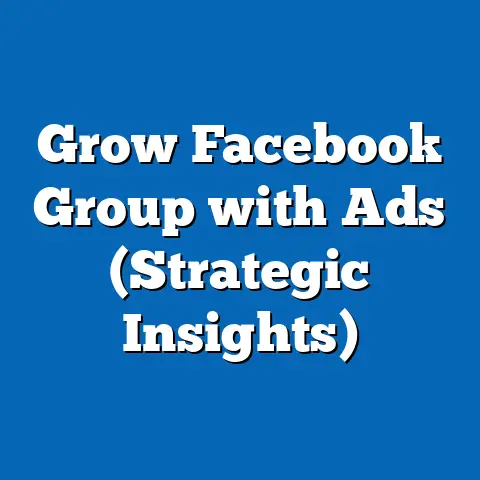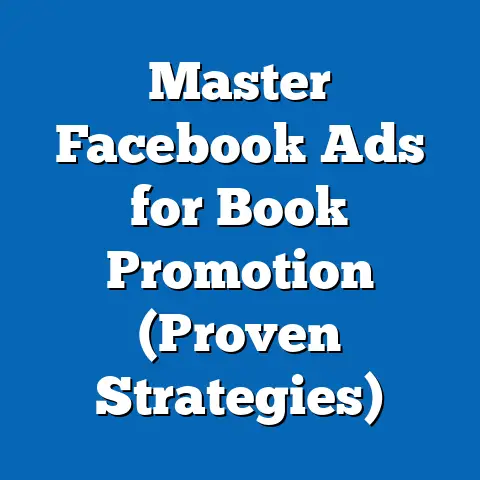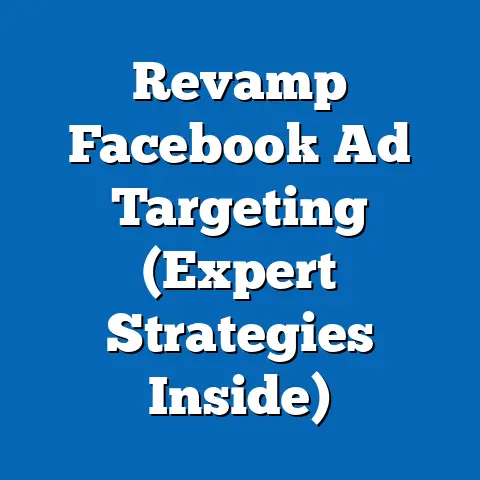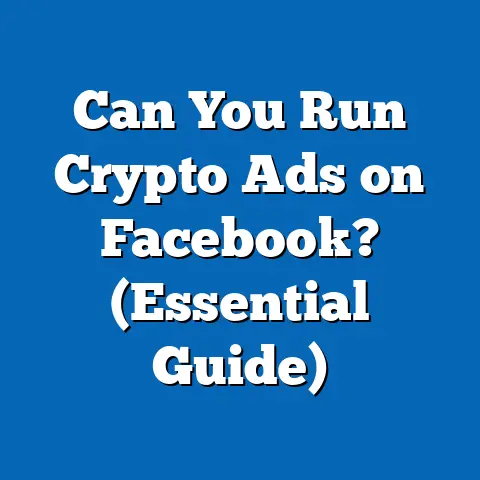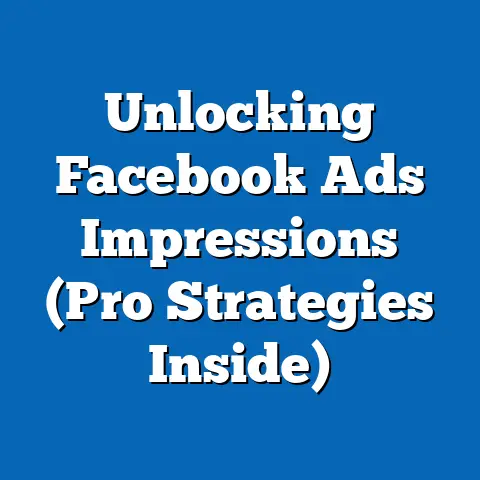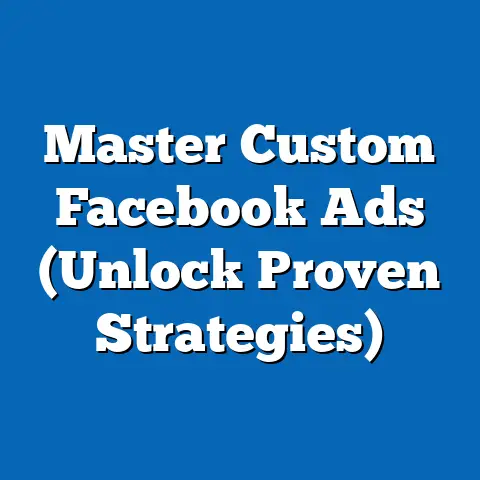Is Facebook the Best Ad Platform for Business? (Pro Insights)
In the realm of pop culture, few phenomena have shaped modern communication and influence as profoundly as social media platforms like Facebook. From the viral memes of the early 2010s to the platform’s role in political campaigns and social movements, Facebook has embedded itself into the fabric of global culture, influencing how businesses connect with consumers. This article will analyze whether Facebook remains the best advertising platform for businesses in 2023, drawing from pop culture trends, demographic insights, and data-driven comparisons with other digital advertising platforms.
To contextualize this analysis, it’s critical to understand the demographic makeup of Facebook users, their core beliefs, and their behavioral patterns, as these factors shape how businesses target audiences. Additionally, we’ll examine how pop culture influences user engagement on the platform, comparing it to competitors like Instagram, TikTok, and Google Ads. By grounding this discussion in empirical data and cultural trends, we aim to provide a comprehensive evaluation of Facebook’s effectiveness as an ad platform.
Pop Culture and Facebook: A Demographic and Behavioral Snapshot
Facebook’s cultural significance is undeniable, often portrayed in media as the quintessential social network that connects generations. From movies like The Social Network (2010), which dramatized its founding, to its frequent mentions in TV shows as a tool for reconnection or controversy, Facebook has been a cultural touchstone for over a decade. This cultural resonance is tied to its vast and diverse user base, which spans multiple generations and socioeconomic groups.
Demographic Composition: As of 2023, Facebook boasts approximately 3 billion monthly active users worldwide, making it the largest social media platform by user count (Statista, 2023). In the United States, Pew Research Center data indicates that 69% of adults use Facebook, with usage cutting across age groups: 77% of 30-49-year-olds, 73% of 18-29-year-olds, and 50% of those 65 and older (Pew Research, 2023). Unlike younger-skewing platforms like TikTok, where 67% of users are under 30, Facebook’s user base is notably balanced, with significant representation from Gen X and Baby Boomers.
Core Beliefs and Values: Facebook users, as a broad group, tend to value connectivity and community, often using the platform to maintain relationships, share personal updates, and engage with local or interest-based groups. Surveys from the Knight Foundation (2022) suggest that many users see Facebook as a primary source for news and information, though trust in content varies by age and political affiliation. Younger users often express skepticism about privacy and data use, while older users prioritize ease of communication over such concerns.
Voting Patterns and Political Engagement: Facebook’s role in political discourse is well-documented, with the platform serving as a key space for political ads and activism. During the 2020 U.S. Presidential Election, Facebook ad spending reached $1.3 billion, with campaigns targeting specific demographics based on age, location, and interests (OpenSecrets, 2020). Data shows that older users (50+) are more likely to engage with political content, with 60% reporting they’ve shared or commented on political posts compared to 45% of 18-29-year-olds (Pew Research, 2021). This engagement makes Facebook a potent tool for businesses targeting politically active or issue-driven consumers.
Distinguishing Characteristics Compared to Other Groups: Compared to platforms like Instagram (where 59% of users are under 30) or TikTok (focused on short-form, trend-driven content), Facebook’s distinguishing feature is its broad demographic reach and emphasis on long-form engagement through groups, events, and pages (Hootsuite, 2023). Unlike Google Ads, which focuses on search intent, Facebook leverages social connections and behavioral data for hyper-targeted advertising. This social-first approach sets it apart, though it also raises unique challenges around privacy concerns and ad fatigue among younger users.
Facebook as an Advertising Platform: Key Characteristics
To assess whether Facebook is the best ad platform for businesses, we must break down its strengths and weaknesses across several dimensions, including audience reach, targeting capabilities, cost-effectiveness, and user engagement. These factors will be compared to other major platforms to provide a balanced perspective.
1. Audience Reach and Demographic Targeting
Facebook’s unparalleled user base offers businesses access to a diverse audience, making it a strong choice for campaigns targeting multiple age groups or geographies. With 2.1 billion daily active users as of Q2 2023 (Meta, 2023), businesses can reach nearly a third of the global population through a single platform. Its advanced targeting options—based on demographics, interests, behaviors, and even life events—allow for precision that few competitors can match.
For instance, a business selling retirement planning services can target users aged 50-65 with specific interests in finance, while a youth-oriented brand can focus on 18-24-year-olds interested in fashion or music festivals. Data from Sprout Social (2023) indicates that 78% of businesses report successful audience targeting on Facebook, compared to 65% on Instagram and 55% on TikTok. This granularity is a key advantage over broader platforms like Google Ads, which rely more on search intent than social behavior.
However, demographic shifts pose challenges. Younger users are increasingly migrating to TikTok and Instagram, with only 32% of U.S. teens using Facebook regularly compared to 67% for TikTok (Pew Research, 2022). Businesses targeting Gen Z may find Facebook less effective unless paired with other platforms.
2. Cost-Effectiveness and Return on Investment (ROI)
Facebook Ads are often praised for their affordability and measurable ROI, particularly for small and medium-sized businesses (SMBs). The average cost-per-click (CPC) on Facebook is $1.72, significantly lower than Google Ads’ $2.69 for search campaigns (WordStream, 2023). Additionally, Facebook’s cost-per-thousand-impressions (CPM) averages $7.19, compared to $20.90 on LinkedIn (Hootsuite, 2023).
ROI data further supports Facebook’s value. A 2022 study by HubSpot found that businesses earn an average of $5.20 for every $1 spent on Facebook Ads, outperforming Twitter (now X) at $3.80 and Instagram at $4.20. This high return is attributed to Facebook’s detailed analytics through tools like Meta Business Suite, which allow businesses to track conversions, adjust campaigns in real-time, and optimize ad spend.
Yet, costs can vary widely by industry and audience. Competitive sectors like finance or legal services see CPCs as high as $3.77, while less competitive niches like arts and entertainment average $0.61 (WordStream, 2023). Businesses must also contend with “ad fatigue,” as 54% of users report ignoring ads due to overexposure (Statista, 2022).
3. Engagement and Ad Formats
Facebook offers a variety of ad formats—carousel ads, video ads, Stories, and Marketplace ads—that cater to different business goals, from brand awareness to direct sales. Video ads, in particular, drive high engagement, with 62% of users watching videos on the platform daily (Meta, 2023). Engagement rates for Facebook Ads average 0.90%, higher than Twitter’s 0.50% but lower than Instagram’s 1.10% (Sprout Social, 2023).
One distinguishing feature is Facebook’s integration with community-driven features like Groups and Events, allowing businesses to build organic engagement alongside paid campaigns. For example, a local restaurant might promote an event through a targeted ad while fostering discussion in a community group, blending paid and organic strategies.
However, user engagement is declining in some demographics. Younger users report lower interaction with ads, with only 29% of 18-24-year-olds clicking on sponsored content compared to 45% of 35-54-year-olds (eMarketer, 2023). This trend suggests that while Facebook excels in engagement for older audiences, businesses targeting youth may need complementary platforms.
4. Policy Positions and Privacy Concerns
Facebook’s advertising ecosystem is shaped by its policies on data use and privacy, which have evolved in response to public scrutiny and regulations like the General Data Protection Regulation (GDPR) and California Consumer Privacy Act (CCPA). The platform’s reliance on user data for targeting has been a double-edged sword—while it enables precise ads, it has also led to backlash over privacy breaches, such as the 2018 Cambridge Analytica scandal.
Apple’s iOS 14.5 update in 2021, which introduced App Tracking Transparency (ATT), further disrupted Facebook’s ad model by limiting data collection. Meta reported a $10 billion revenue loss in 2022 due to these changes, as 60% of iOS users opted out of tracking (Forbes, 2022). This has reduced ad effectiveness for some businesses, particularly those reliant on cross-app tracking.
In contrast, platforms like Google Ads, which focus on search intent rather than personal data, have been less impacted by privacy changes. Businesses must weigh these constraints when choosing Facebook, though Meta’s ongoing investments in AI-driven targeting aim to mitigate these losses.
Comparison with Other Platforms
To determine if Facebook is the “best” ad platform, it’s essential to compare it with key competitors: Instagram, TikTok, Google Ads, and LinkedIn. Each platform serves different purposes and audiences, and their effectiveness depends on business goals.
-
Instagram: Owned by Meta, Instagram shares many of Facebook’s targeting capabilities but skews younger, with 59% of users under 30 (Pew Research, 2023). It excels in visual storytelling, with higher engagement rates (1.10% vs. Facebook’s 0.90%), but its CPC is slightly higher at $1.84 (WordStream, 2023). Best for lifestyle, fashion, and youth-focused brands, Instagram complements rather than replaces Facebook.
-
TikTok: With 1.7 billion monthly active users, TikTok dominates among Gen Z, with 67% of U.S. teens using it regularly (Pew Research, 2022). Its ad engagement is high due to viral trends, but CPC averages $1.82, and its user base is less diverse than Facebook’s (Statista, 2023). Ideal for creative, trend-driven campaigns, TikTok lacks the broad reach of Facebook for multi-generational targeting.
-
Google Ads: Google’s strength lies in search intent, capturing users at the moment of purchase decision. Its CPC is higher ($2.69), but conversion rates are often superior, with 3.75% for search ads compared to Facebook’s 1.85% (WordStream, 2023). Google is best for direct response campaigns, while Facebook excels in brand awareness and social engagement.
-
LinkedIn: Focused on B2B marketing, LinkedIn’s user base is professional, with 60% of users aged 25-34 and high-income earners (Hootsuite, 2023). Its CPM is steep ($20.90), but it offers unparalleled targeting for corporate audiences. Unlike Facebook, LinkedIn is niche, lacking the mass-market appeal for most consumer businesses.
Intersections with Demographic Factors
Facebook’s ad effectiveness varies across demographic intersections like age, education, race, and income, reflecting broader social trends. For instance, data shows that 75% of college-educated adults use Facebook compared to 61% of those with a high school diploma or less (Pew Research, 2023), suggesting stronger reach among higher-educated audiences. Racial demographics also play a role, with 74% of Black adults and 71% of Hispanic adults using the platform, compared to 67% of White adults, making it a valuable tool for culturally targeted campaigns.
Age remains the most significant divide. While older users (50+) show higher engagement with ads and content, younger users are less receptive, often using ad blockers or spending more time on Instagram and TikTok (eMarketer, 2023). Income levels also influence behavior, with higher-income users ($75,000+) more likely to make purchases through Facebook Marketplace ads (Statista, 2023).
Areas of Consensus and Division Among Businesses
Among businesses, there’s consensus that Facebook offers unmatched reach and targeting precision, particularly for SMBs with limited budgets. Surveys indicate that 89% of marketers use Facebook Ads, more than any other platform (HubSpot, 2023). Its integration with Instagram and WhatsApp (via Meta) also provides a seamless ecosystem for multi-channel campaigns.
However, divisions exist over its long-term viability. Some businesses, especially those targeting Gen Z, argue that TikTok and Instagram offer better cultural relevance and engagement. Privacy concerns also split opinions—while 64% of marketers trust Meta’s data security post-2021 updates, 36% remain skeptical and prioritize platforms with less reliance on personal data (Sprout Social, 2023).
Historical and Social Context
Facebook’s evolution as an ad platform must be viewed in the context of broader digital trends. Launched in 2004 as a college networking site, it pivoted to advertising in 2007 with the introduction of Facebook Ads. Its growth mirrored the rise of social media as a cultural force, peaking in the 2010s as a hub for political and social discourse.
The platform’s ad model thrived on data collection, but high-profile scandals and regulatory changes have forced adaptations. The shift to privacy-focused policies reflects a societal push for transparency, aligning with global movements against Big Tech dominance. Historically, Facebook’s ability to adapt—through acquisitions like Instagram and innovations like Reels—has kept it competitive, though its dominance is no longer unchallenged as younger platforms gain traction.
Conclusion: Is Facebook the Best Ad Platform for Business?
Facebook remains a powerhouse in digital advertising, offering unmatched reach, sophisticated targeting, and cost-effective solutions for businesses of all sizes. Its demographic diversity, with strong representation across age groups and income levels, makes it uniquely versatile compared to niche platforms like TikTok or LinkedIn. Data supports its high ROI, with $5.20 earned per $1 spent, and 78% of businesses reporting successful targeting outcomes (HubSpot, 2023; Sprout Social, 2023).
However, it is not universally the “best” platform. Businesses targeting Gen Z may find TikTok or Instagram more effective due to higher engagement and cultural relevance, while B2B companies might prioritize LinkedIn. Privacy constraints and ad fatigue also pose challenges, particularly for iOS users and younger demographics less receptive to sponsored content.
Ultimately, the decision depends on business goals, target audience, and budget. For broad-reach, multi-generational campaigns with a focus on community engagement, Facebook is often the top choice. Yet, a multi-platform strategy—combining Facebook with Instagram for visuals or Google Ads for intent-driven conversions—may yield the best results in an increasingly fragmented digital landscape. As pop culture and user behavior continue to evolve, businesses must remain agile, leveraging data to adapt their advertising strategies across platforms.

